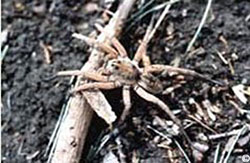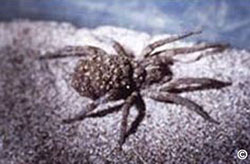What are wolf spiders?
 Wolf spiders, among the largest spiders found in Colorado, are often mistaken as tarantulas. These beneficial spiders are foraging hunters that do not spin a web to capture food. Wolf spiders are often encountered by people in the late summer/early fall as they search for food, mates or wintering sites. These spiders are not poisonous and would rather run than bite. They generally do not become established in homes.
Wolf spiders, among the largest spiders found in Colorado, are often mistaken as tarantulas. These beneficial spiders are foraging hunters that do not spin a web to capture food. Wolf spiders are often encountered by people in the late summer/early fall as they search for food, mates or wintering sites. These spiders are not poisonous and would rather run than bite. They generally do not become established in homes.
How big do wolf spiders get?
 Wolf spiders vary from 1/2 inch to 2 inches in length, appear hairy and are typically brown, black, gray, or yellow with various markings. The females carry their large egg sacs around to protect them from predators. Upon hatching, the spiderlings climb onto their mother’s back where they remain until partially grown.
Wolf spiders vary from 1/2 inch to 2 inches in length, appear hairy and are typically brown, black, gray, or yellow with various markings. The females carry their large egg sacs around to protect them from predators. Upon hatching, the spiderlings climb onto their mother’s back where they remain until partially grown.
How can I control the spiders around my house?
Spider control is best done on an as needed basis. Capturing and carrying the spider back outdoors is recommended, since they are beneficial. In cases where the person cannot tolerate the spider or can’t move it, shoes, fly swatters, or a rolled up newspaper are sufficient for elimination. A pesticide spray for spiders is not recommended, unless the infestation seems severe.
For more information, see the following Colorado State University Extension fact sheet(s).



